Satellite-Based Study and Numerical Forecasting of Two Tornado Outbreaks in the Ural Region in June 2017
Abstract
:1. Introduction
2. Data and Methods
2.1. Overview of the Data Sources
2.2. Tornado Tracks Identification and Characteristics Estimate
2.3. WRF Model Configuration and Forecast Accuracy Assessment
3. Storm Events Description
3.1. Large-Scale Synoptic Features
3.2. Diagnostic Variables, Estimated by the Global NWP Models, and Sounding Data
3.3. Convective Storms Evolution
3.4. The Main Characteristics of Tornadoes and Associated Severe Weather Events
4. Results of Modeling
4.1. WRF Model Forecasts with Various Horizontal Grid Spacing
4.1.1. Determination of the Most Appropriate Model Grid Spacing
4.1.2. Validation of the Simulation Results with the Meteosat-8 Images
4.2. Sensitivity of Simulation Results to Forecast Lead Time
5. Discussion and Conclusions
Supplementary Materials
Author Contributions
Funding
Conflicts of Interest
Appendix A. Information on Severe Weather Indices Calculations and Additional Information on Tornadoes and Squalls
| Indices (Acronym) | Indices (Full Name) | Equation | Reference |
|---|---|---|---|
| SB CAPE, J Kg−1 | Surface-based convective available potential energy | [78] | |
| SB CIN, J Kg−1 | Surface-based Convective inhibition | [78] | |
| SB LI, °C | Surface-based Lifted Index | [78] | |
| LLS, m s−1 | Low-level shear | [59] | |
| DLS, m s−1 | Deep layer shear | [59] | |
| WMAXSHEAR, m2 s−2 | WMAXSHEAR | [59] | |
| 0–3 km SRH, m2 s−2 | 0–3 km Storm-Relative Helicity | [78] | |
| EHI | Energy-helicity Index | [60,78] | |
| SCP | Supercell Composite Parameter | [60] | |
| STP | Significant Tornado Parameter | [3] |
| Tornado Number | Data Quality | Coordi Nates (Start) | Coordi- Nates (End) | Time (UTC) | Data Sources | The Most Probable Intensity Rating and Three Tornado Intensity According to Various Methods * | Damaged Settlements | Damage to Settlements and Infrastructure | Move- Ment Direction | Forest Damage Track | |
|---|---|---|---|---|---|---|---|---|---|---|---|
| Path Length (km) and Maximum Width (m) | Confirmation with High-Resolution Image and Its Date | ||||||||||
| 3 June 2017 | |||||||||||
| 1.1 | Medium | 56.231 N 59.743 E | 56.234 N 59.737 E | 1055 | Satellite data | IF0 IF0/-/≥F0 | 4 km SW of Kenchurka | Forest damage | SE-NW | 0.5/100 | - |
| 1.2 | High | 57.190 N 59.310 E | 57.429 N 59.410 E | 1115 | Eyewitness photo and video, damage photo and video, satellite data | IF2 IF2/EF4/≥F2 | Staroutkinsk | Dozens of houses damaged, roofs destroyed, forest damage (total canopy removal) | SSW- NNE | 28.5/1240 | + 12 May 2019 |
| 1.3 | High | 57.482 N 59.414 E | 57.769 N 59.462 E | 1145 | Eyewitness video, damage photo, satellite and aerial images | IF3 IF2/EF4/≥F3 | 4 km from Visim | Forest damage (total canopy removal) | SSW- NNE | 33.3/1590 | + 5 Oct 2019 7 Oct 2019 |
| 1.4 | High | 57.338 N 59.747 E | 57.354 N 59.757 E | 1215 | Satellite data | IF1 ≥IF1/EF0/≥F1 | 9 km WNW of Polovinny | Forest damage | SSW-NNE | 1.9/240 | + 14 Sep 2017 |
| 1.5 | Medium | 59.264 N 59.120 E | 59.268 N 59.116 E | 1215 | Satellite data | IF0 -/-/F0 | 27 km SSW of Kytlym | Forest damage | SSE-NNW | 0.6/100 | - |
| 1.6 | High | - | - | 1220 | Eyewitness video | IF0 -/-/- | Near Beloyarsky | No damage | - | -/- | - |
| 1.7 | High | 56.816 N 61.376 E | 56.829 N 61.383 E | 1225 | Satellite data | IF1 ≥IF1/EF1/≥F1 | 3 km ENE of Zarechny | Forest damage | SSW- NNE | 1.5/140 | + 12 May 2019 |
| 1.8 | High | 57.278 N 60.590 E | 57.284 N 60.589 E | 1245 | Satellite data | IF1 ≥IF1/EF1/≥F0 | 5 km NW of Ol’khovka | Forest damage | SSE- NNW | 0.7/100 | + 29 Aug 2017 |
| 1.9 | High | 57.770 N 60.396 E | 57.773 N 60.394 E | 1250 | Satellite data | IF1 ≥IF1/EF1/≥F0 | 3 km E of Vilyui | Forest damage | SSE- NNW | 0.3/70 | + 18 Jul 2017 |
| 1.10 | High | 57.774 N 60.233 E | 57.817 N 60.242 E | 1250 | Satellite data | IF2 ≥IF1/EF1/≥F2 | 4 km E of Shilovka | Forest damage | S-N | 4.8/490 | + 11 Aug 2017 |
| 1.11 | High | 57.694 N 59.975 E | 57.724 N 59.974 E | 1250 | Satellite data | IF1 ≥IF1/EF2/≥F1 | 6 km ESE of Chernoistochnik | Forest damage | S-N | 3.4/210 | + 30 Jun 2018 |
| 1.12 | High | 57.870 N 60.222 E | 57.893 N 60.220 E | 1255 | Satellite data | IF1 ≥IF1/EF1/≥F1 | 6 km E of Zonal’ny | Forest damage | S-N | 2.6/310 | + 11 Aug 2017 |
| 1.13 | High | 57.936 N 60.220 E | 57.942 N 60.219 E | 1300 | Satellite data | IF1 IF0/EF0/≥F1 | 4 km SW of Pokrovskoe | Forest damage | SSE- NNW | 0.7/150 | + 11 Aug 2017 |
| 1.14 | High | 58.011 N 60.306 E | 58.042 N 60.319 E | 1315 | Satellite data | IF1 ≥IF1/EF2/≥F1 | 1 km NNE of Molodezhny | Forest damage | SSW- NNE | 3.5/280 | + 2 Sep 2017 |
| 1.15 | High | 58.078 N 60.267 E | 58.085 N 60.273 E | 1315 | Satellite data | IF1 ≥IF1/EF0/≥F0 | 8 km NW of Svobodny | Forest damage | SSW- NNE | 0.8/80 | + 2 Sep 2017 |
| 1.16 | High | 58.127 N 60.399 E | 58.138 N 60.395 E | 1315 | Satellite data | IF1 ≥IF1/EF1/≥F1 | 10 km N of Svobodny | Forest damage | SSE- NNW | 1.3/200 | + 23 May 2018 |
| 1.17 | High | 58.670 N 60.177 E | 58.688 N 60.173 E | 1400 | Satellite data | IF1 ≥IF1/EF2/≥F1 | 4 km E of Novaya Tura | Forest damage | SSE- NNW | 2.1/280 | + 19 Jul 2019 |
| 1.18 | High | 58.959 N 59.763 E | 58.984 N 59.752 E | 1415 | Satellite data | IF1 ≥IF1/EF1/≥F1 | 2 km W of Chernichny | Forest damage | SSE- NNW | 3.0/360 | + 7 Sep 2019 |
| 1.19 | Medium | 60.564 N 58.994 E | 60.583 N 59.012 E | 1430 | Satellite data | IF1 -/-/≥F1 | 27 km E of Ust-Uls | Forest damage | SSW- NNE | 2.4/140 | - |
| 1.20 | High | 59.167 N 61.386 E | 59.186 N 61.370 E | 1445 | Satellite data | IF1 ≥IF1/EF1/≥F1 | 3 km WNW of Yakimovo | Forest damage | SSE- NNW | 2.3/170 | + 14 Sep 2019 |
| 1.21 | Medium | 59.493 N 61.156 E | 59.496 N 61.148 E | 1530 | Satellite data | IF0 -/-/F0 | 12 km NNW of Krasnoglinny | Forest damage | SE-NW | 0.6/60 | - |
| 1.22 | Medium | 59.800 N 61.019 E | 59.850 N 60.948 E | 15:30 | Satellite data | IF1 -/-/F1 | 13 km E of Krasny Yar | Forest damage | SE-NW | 6.8/300 | - |
| 1.23 | High | 59.800 N 60.520 E | 59.816 N 60.501 E | 1540 | Satellite data | IF1 ≥IF1/EF3/≥F1 | 3 km NNE of Podgarnichny | Forest damage | SE-NW | 2.2/200 | + 3 Sep 2018 |
| 1.24 | High | 59.967 N 59.849 E | 59.977 N 59.860 E | 1545 | Satellite data | IF1 ≥IF1/EF1/≥F0 | 5 km NNE of Sosnovka | Forest damage | SSW- NNE | 1.4/90 | + 7 Aug 2017 |
| 1.25 | High | 59.935 N 60.528 E | 59.975 N 60.487 E | 1545 | Satellite data | IF2 ≥IF1/EF1/≥F2 | 4 km NW of Lar’kovka | Forest damage | SSE- NNW | 5.1/510 | + 7 Aug 201723 Aug 2017 |
| 1.26 | High | 60.259 N 59.924 E | 60.272 N 59.920 E | 1600 | Satellite data | IF1 ≥IF1/EF1/≥F1 | 5 km NW of Kal’ya | Forest damage | SSE- NNW | 1.6/270 | + 5 Jul 2017 |
| 1.27 | High | 60.661 N 59.407 E | 60.681 N 59.398 E | 1610 | Satellite data | IF1 IF0/EF0/≥F1 | 34 km ESE of Vels | Forest damage | SSE- NNW | 2.5/130 | + 11 Aug 2017 |
| 1.28 | High | 60.661 N 59.504 E | 60.690 N 59.503 E | 1630 | Satellite data | IF1 IF0/EF0/≥F1 | 30 km NW of Vsevolodo-Blagodatskoe | Forest damage | S-N | 3.3/220 | + 11 Aug 2017 |
| 18 June 2017 | |||||||||||
| 2.1 | High | 55.145 N 66.590 E | 55.238 N 66.585 E | 1105 | Eyewitness video, satellite data | IF2 ≥IF1/EF4/≥F2 | Baksary | Forest damage (total canopy removal) | S-N | 10.5/900 | + 1 Mar 2018 |
| 2.2 | High | - | - | 1105 | Eyewitness video | IF0 -/-/- | NE of Baksary | No damage | - | - | - |
| 2.3 | Medium | - | - | 1110 | Eyewitness report | IF0 IF0/-/- | Tsentralnoe | Few roofs of houses slightly damaged | - | - | - |
| 2.4 | High | 55.501 N 66.636 E | 55.670 N 66.560 E | 1135 | Eyewitness report, damage photo and video, satellite data | IF4 IF4/EF5/≥F3 | Maloye Pes’yanovo | Four houses totally destroyed, another 25 seriously damaged, forest damage (total canopy removal) | SSE- NNW | 20.3/1750 | + 30 Jun 2017 |
| 2.5 | High | 55.668 N 66.458 E | 55.752 N 66.420 E | 1145 | damage photo, satellite data | IF2 IF2/EF3/≥F2 | Novotroitskoe | Houses damaged, forest damage (total canopy removal) | SSE- NNW | 10.0/790 | + 30 Jun 2017 |
| 2.6 | High | 56.452 N 66.493 E | 56.496 N 66.437 E | 1300 | Eyewitness video, satellite data | IF2 ≥IF1/EF4/≥F2 | 4 km WSW of Zavodoukovsk | Forest damage (total canopy removal) | SE-NW | 6.0/580 | + 27 Apr 2018 |
| 2.7 | High | 57.133 N 65.303 E | 57.153 N 65.275 E | 1350 | Satellite data | IF1 ≥IF1/EF3/≥F1 | 2 km E of Gor’kovka | Forest damage | SE-NW | 2.9/280 | + 24 Aug 2017 |
| 2.8 | High | 57.269 N 66.417 E | 57.273 N 66.407 E | 1400 | Satellite data | IF1 ≥IF1/EF2/≥F1 | 13 km E of Kunchur | Forest damage | SE-NW | 0.7/200 | + 2 Aug 2017 |
| 2.9 | High | 58.061 N 64.415 E | 58.074 N 64.383 E | 1545 | Satellite data | IF1 ≥IF1/EF1/≥F1 | 6 km NNW of Saragulka | Forest damage | SE-NW | 2.4/190 | + 14 Jul 2018 |
| Report Type | Coordinates (Weather Station or Central Point of Windthrow Area) | WMO ID of the Weather Station | Time (UTC) | Reported Wind Gust (m s−1) | Damaged Settlements | Damage Description | Accompanied Weather Events | Move- Ment Direction | Forest Damage Track | |
|---|---|---|---|---|---|---|---|---|---|---|
| Path Length (km) and Maximum Width (km) | Damaged Area, ha | |||||||||
| 3 June 2017 | ||||||||||
| Weather station report | 57.88 N 60.07 E | 28440 | 1300 | 26 | Nizhniy Tagil | One fatality, 10 injured, 166 million rubles (~$3 millions) of damage (buildings, cars and trees damaged) | Heavy rainfall | S-N | - | - |
| 54.55 N 60.30 E | 28741 | 25 | Mirniy | Trees and cars damaged, power supply of 46 settlements was interrupted | Hail with 35 mm in daimeter | S-N | - | - | ||
| 57.45 N 61.17 E | 28345 | 1200 (±1 h) | 27 | Lipovskoe | No data | No data | S-N | - | - | |
| Forest damage | 58.71 N 60.16 E | - | 1400 (±1 h) | - | - | Trees damaged in Lesnoy and Nizhnya Tura | No data | S-N | 6.7/1.3 | 50 |
| 58.12 N 60.07 E | - | 1300 | - | - | Buildings, cars and trees damaged in Nizhniy Tagil | No data | S-N | 31.0/22.2 | 192 | |
| 58.81 N 59.51 E | - | 1400 (±1 h) | - | - | Buildings, cars and trees damaged in the nearest towns Kachkanar | Hail with 40 mm in daimeter | S-N | 24.8/3.1 | 472 | |
| 18 June 2017 | ||||||||||
| Weather station report | 56.02 N 65.70 E | 28561 | 1200 (±1 h) | 26 | Pamyatnoe | Power lines damage, tree damage | No data | SSE- NNW | - | - |
| 55.28 N 66.50 E | 28662 | 1100 (±1 h) | 25 | Lebyazhie | Power lines damage, tree damage | No data | SSE- NNW | - | - | |
| Forest damage | 55.71 N 66.48 E | - | 1200 (±30 min) | - | - | Buildings and trees damaged in the settlements of the Mokrousovsky district | No data | SSE- NNW | 19.1/5.1 | 37 |
References
- Antonescu, B.; Schultz, D.M.; Holzer, A.; Groenemeijer, P. Tornadoes in Europe: An Underestimated Threat. Bull. Am. Meteorol. Soc. 2017, 98, 713–728. [Google Scholar] [CrossRef]
- Chernokulsky, A.; Kurgansky, M.; Mokhov, I.; Shikhov, A.; Azhigov, I.; Selezneva, E.; Zakharchenko, D.; Antonescu, B.; Kühne, T. Tornadoes in Northern Eurasia: From the Middle Age to the Information Era. Mon. Weather Rev. 2020, 148, 3081–3111. [Google Scholar] [CrossRef] [Green Version]
- Grieser, J.; Haines, P. Tornado Risk Climatology in Europe. Atmosphere 2020, 11, 768. [Google Scholar] [CrossRef]
- Snitkovskiy, A.I. Tornadoes in the USSR. Sov. Meteorol. Gidrol. 1987, 9, 12–25. (In Russian) [Google Scholar]
- Fujita, T.T. Tornadoes and downbursts in the context of generalized planetary scales. J. Atmos. Sci. 1981, 38, 1511–1534. [Google Scholar] [CrossRef] [Green Version]
- Finch, J.; Bikos, D. Russian tornado outbreak of 9 June 1984. Electron. J. Sev. Storms Meteorol. 2012, 7, 1–28. [Google Scholar]
- Kurgansky, M.V.; Chernokulsky, A.V.; Mokhov, I.I. The tornado over Khanty-Mansiysk: An exception or a symptom? Russ. Meteorol. Hydrol. 2013, 38, 539–546. [Google Scholar] [CrossRef]
- Hannesen, R.; Dotzek, N.; Gysi, H.; Beheng, K.D. Case study of a tornado in the Upper Rhine valley. Meteorol. Z. 1998, 7, 163–170. [Google Scholar] [CrossRef]
- Wesolek, E.; Mahieu, P. The F4 tornado of August 3, 2008, in Northern France: Case study of a tornadic storm in a low CAPE environment. Atmos. Res. 2011, 100, 649–656. [Google Scholar] [CrossRef]
- Chernokulsky, A.V.; Shikhov, A.N. 1984 Ivanovo tornado outbreak: Determination of actual tornado tracks with satellite data. Atmos. Res. 2018, 207, 111–121. [Google Scholar] [CrossRef]
- Shikhov, A.N.; Bykov, A.V. Study of two cases of severe tornadoes in the Predural’e region. Sovrem. Probl. Distantsionnogo Zondirovaniya Zemli iz Kosm. 2015, 12, 124–133. (In Russian) [Google Scholar]
- Putsay, M.; Simon, A.; Szenyán, I.; Kerkmann, J.; Horváth, G. Case study of the 20 May 2008 tornadic storm in Hungary—Remote sensing features and NWP simulation. Atmos. Res. 2011, 100, 657–679. [Google Scholar] [CrossRef]
- Rodriguez, O.; Bech, J. Reanalysing strong-convective wind damage paths using high-resolution aerial images. Nat. Hazards 2020, 104, 1021–1038. [Google Scholar] [CrossRef]
- Novitskii, M.A.; Pavlyukov, Y.B.; Shmerlin, B.Y.; Makhnorylova, S.V.; Serebryannik, N.I.; Petrichenko, S.A.; Tereb, L.A.; Kalmykova, O.V. The tornado in Bashkortostan: The potential of analyzing and forecasting tornado-risk conditions. Russ. Meteorol. Hydrol. 2016, 41, 683–690. [Google Scholar] [CrossRef]
- Rodríguez, O.; Bech, J.; Soriano, J.D.D.; Gutiérrez, D.; Castán, S. A methodology to conduct wind damage field surveys for high-impact weather events of convective origin. Nat. Hazards Earth Syst. Sci. 2020, 20, 1513–1531. [Google Scholar] [CrossRef]
- Chernokulsky, A.V.; Kurgansky, M.V.; Zakharchenko, D.I.; Mokhov, I.I. Genesis Environments and Characteristics of the Severe Tornado in the South Ural on August 29, 2014. Russ. Meteorol. Hydrol. 2015, 40, 794–799. [Google Scholar] [CrossRef]
- Taszarek, M.; Czernecki, B.; Walczakiewicz, S.; Mazur, A.; Kolendowicz, L. An isolated tornadic supercell of 14 July 2012 in Poland—A prediction technique within the use of coarse-grid WRF simulation. Atmos. Res. 2016, 178–179, 367–379. [Google Scholar] [CrossRef]
- Šinger, M.; Púčik, T. A challenging tornado forecast in Slovakia. Atmosphere 2020, 11, 821. [Google Scholar] [CrossRef]
- Dmitrieva, T.G.; Peskov, B.E. Synoptic conditions, nowcasting, and numerical prediction of severe squalls and tornados in Bashkortostan on June 1, 2007 and August 29, 2014. Russ. Meteorol. Hydrol. 2016, 41, 673–682. [Google Scholar] [CrossRef]
- Novitskii, M.A.; Shmerlin, B.Y.; Petrichenko, S.A.; Tereb, L.A.; Kulizhnikova, L.K.; Kalmykova, O.V. Using the indices of convective instability and meteorological parameters for analyzing the tornado-risk conditions in Obninsk on May 23, 2013. Russ. Meteorol. Hydrol. 2015, 40, 79–84. [Google Scholar] [CrossRef]
- Shafer, C.M.; Mercer, A.E.; Doswell, C.A., III; Richman, M.B.; Leslie, L.M. Evaluation of WRF forecasts of tornadic and nontornadic outbreaks when initialized with synoptic-scale input. Mon. Weather Rev. 2009, 137, 1250–1271. [Google Scholar] [CrossRef] [Green Version]
- Pilguj, N.; Taszarek, M.; Pajurek, L.; Kryza, M. High-resolution simulation of an isolated tornadic supercell in Poland on 20 June 2016. Atmos. Res. 2019, 218, 145–159. [Google Scholar] [CrossRef]
- Roebber, P.J.; Schultz, D.M.; Romero, R. Synoptic regulation of the 3 May 1999 tornado outbreak. Weather Forecast. 2002, 17, 399–429. [Google Scholar] [CrossRef] [Green Version]
- Kain, J.S.; Weiss, S.J.; LevIt, J.J.; Baldwin, M.E.; Bright, D.R. Examination of convection-allowing configurations of the WRF model for the prediction of severe convective weather: The SPC/NSSL Spring Program 2004. Weather Forecast. 2006, 21, 167–181. [Google Scholar] [CrossRef] [Green Version]
- Grell, G.; Dudhia, J.; Stauffer, D. A Description of the Fifth-Generation Penn State/NCAR Mesoscale Model (MM5); NCAR Tech. Note NCAR/TN-398 + STR; University Corporation for Atmospheric Research: Boulder, CO, USA, 1996; 117p. [Google Scholar] [CrossRef]
- Xue, M.; Droegemeier, K.K.; Wong, V. The Advanced Regional Prediction System (ARPS)—A multi-scale nonhydrostatic atmospheric simulation and prediction model. Part I: Model dynamics and verification. Meteorol. Atmos. Phys. 2000, 75, 161–193. [Google Scholar] [CrossRef]
- Xue, M.; Wand, D.; Gao, J.; Brewster, K.; Droegemeier, K.K. The Advanced Regional Prediction System (ARPS), storm-scale numerical weather prediction and data assimilation. Meteorol. Atmos. Phys. 2003, 82, 139–170. [Google Scholar] [CrossRef]
- Kain, J.S.; Weiss, S.J.; Bright, D.R.; Baldwin, M.E.; Levit, J.J.; Carbin, G.W.; Schwartz, C.S.; Weisman, M.L.; Droegemeier, K.K.; Weber, D.B.; et al. Some practical considerations regarding horizontal resolution in the first generation of operational convection-allowing NWP. Weather Forecast. 2008, 23, 931–952. [Google Scholar] [CrossRef]
- Weisman, M.L.; Davis, C.; Wang, W.; Manning, K.W.; Klemp, J.B. Experiences with 0–36-h explicit convective forecasts with the WRF-ARW model. Weather Forecast. 2008, 23, 407–437. [Google Scholar] [CrossRef]
- Sobash, R.A.; Kain, J.S.; Bright, D.R.; Dean, A.R.; Coniglio, M.C.; Weiss, S.J. Probabilistic forecast guidance for severe thunderstorms based on the identification of extreme phenomena in convection-allowing model forecasts. Weather Forecast. 2011, 26, 714–728. [Google Scholar] [CrossRef]
- Clark, A.J.; Kain, J.S.; Marsh, P.T.; Correia, J.; Xue, M.; Kong, F. Forecasting tornado pathlengths using a three-dimensional object identification algorithm applied to convection-allowing forecasts. Weather Forecast. 2012, 27, 1090–1113. [Google Scholar] [CrossRef]
- Clark, A.J.; Gao, J.; Marsh, P.T.; Smith, T.; Kain, J.S.; Correia, J., Jr.; Xue, M.; Kong, F. Tornado pathlength forecasts from 2010 to 2011 using ensemble updraft helicity. Weather Forecast. 2013, 28, 387–407. [Google Scholar] [CrossRef] [Green Version]
- Sobash, R.A.; Romine, G.S.; Schwartz, G.S. Explicit Forecasts of Low-Level Rotation from Convection-Allowing Models for Next-Day Tornado Prediction. Weather Forecast. 2016, 31, 1591–1614. [Google Scholar] [CrossRef]
- Púcik, T.; Groenemeijer, P.; Rýva, D.; Kolář, M. Proximity soundings of severe and nonsevere thunderstorms in central Europe. Mon. Weather Rev. 2015, 143, 4805–4821. [Google Scholar] [CrossRef]
- Kalmykova, O.V.; Shershakov, V.M.; Novitskii, M.A.; Shmerlin, B.Y. Automated Forecasting of Waterspouts off the Black Sea Coast of Russia and Its Performance Assessment. Russ. Meteorol. Hydrol. 2019, 44, 764–771. [Google Scholar] [CrossRef]
- Stratman, D.R.; Brewster, K.A. Sensitivities of 1-km forecasts of 24 May 2011 tornadic supercells to microphysics parameterizations. Mon. Weather Rev. 2017, 145, 2697–2721. [Google Scholar] [CrossRef]
- Fierro, A.O.; Mansell, E.R.; Ziegler, C.L.; MacGorman, D.R. Application of a lightning data assimilation technique in the WRF-ARW model at cloud-resolving scales for the tornado outbreak of 24 May 2011. Mon. Weather Rev. 2012, 140, 2609–2627. [Google Scholar] [CrossRef]
- Jones, T.A.; Stensrud, D.; Wicker, L.; Minnis, P.; Palikonda, R. Simultaneous radar and satellite data storm-scale assimilation using an ensemble kalman filter approach for 24 may 2011. Mon. Weather Rev. 2015, 143, 165–194. [Google Scholar] [CrossRef]
- Skamarock, W.; Klemp, J.; Dudhia, J.; Gill, D.; Barker, D. A Description of the Advanced Research WRF Version 3; NCAR Tech., Note NCAR/TN-475+STR; University Corporation for Atmospheric Research: Boulder, CO, USA, 2008. [Google Scholar]
- Litta, A.J.; Mohanty, U.C.; Bhan, S.C. Numerical simulation of a tornado over Ludhiana (India) using WRF-NMM model. Meteorol. Appl. 2010, 17, 64–75. [Google Scholar] [CrossRef]
- Litta, A.J.; Mohanty, U.C.; Prasad, S.K.; Mohapatra, M.; Tyagi, A.; Sahu, S.C. Simulation of tornado over Orissa (India) on March 31, 2009, using WRF–NMM model. Nat. Hazards 2012, 61, 1219–1242. [Google Scholar] [CrossRef]
- Das, M.K.; Das, S.; Chowdhury, M.A.M.; Karmakar, S. Simulation of tornado over Brahmanbaria on 22 March 2013 using Doppler weather radar and WRF model. Geomat. Nat. Hazards Risk 2016, 7, 1577–1599. [Google Scholar] [CrossRef] [Green Version]
- Matsangouras, I.T.; Pytharoulis, I.; Nastos, P.T. Numerical modeling and analysis of the effect of complex Greek topography on tornadogenesis. Nat. Hazards Earth Syst. Sci. 2014, 14, 1905–1919. [Google Scholar] [CrossRef] [Green Version]
- León-Cruz, J.F.; Carbajal, N.; Pineda-Martínez, L.F. Meteorological analysis of the tornado in Ciudad Acuña, Coahuila State, Mexico, on May 25, 2015. Nat. Hazards 2017, 89, 423–439. [Google Scholar] [CrossRef]
- Romanskii, S.O.; Verbitskaya, E.M.; Ageeva, S.V.; Istomin, D.P. Tornado in the City of Blagoveshchensk on July 31, 2011. Russ. Meteorol. Hydrol. 2018, 43, 574–580. [Google Scholar] [CrossRef]
- Schenkman, A.D.; Xue, M.; Hu, M. Tornadogenesis in a high-resolution simulation of the 8 May 2003 Oklahoma City supercell. J. Atmos. Sci. 2014, 71, 130–154. [Google Scholar] [CrossRef]
- Hurricane Damage in Sverdlovsk Region Exceeded 170 Million Rubles. Available online: https://tass.ru/v-strane/4315705 (accessed on 15 September 2018). (In Russian).
- The Hurricane Caused Millions of Damage to the Zauralye Region. Available online: https://www.znak.com/2017-06-21/uragan_nanes_zauralyu_millionnyy_ucherb_kokorin_prerval_otpusk_chtoby_ocenit_obstanovku (accessed on 15 September 2020). (In Russian).
- European Severe Weather Database. Available online: http://www.eswd.eu (accessed on 15 September 2020).
- Sounding Data Archive. Available online: http://weather.uwyo.edu/upperair/np.html (accessed on 15 September 2020).
- Rasmussen, E.N.; Blanchard, D.O. A baseline climatology of sounding-derived supercell and tornado forecast parameters. Weather Forecast. 1998, 13, 1148–1164. [Google Scholar] [CrossRef] [Green Version]
- EUMETSAT Earth Observation Portal. Available online: https://eoportal.eumetsat.int/userMgmt/login.faces (accessed on 15 September 2020).
- Kerkmann, J.; Lutz, H.J.; König, M.; Prieto, J.; Pylkko, P.; Roesli, H.P.; Rosenfeld, D.; Zwatz-Meise, V.; Schmetz, J.; Schipper, J.; et al. MSG Channels, Interpretation Guide, Weather, Surface Conditions and Atmospheric Constituents. 2006. Available online: http://oiswww.eumetsat.org/WEBOPS/msg_interpretation/index.html. (accessed on 15 August 2018).
- Adler, R.F.; Markus, M.J.; Fenn, D.D. Detection of severe midwest thunderstorms using geosynchronous satellite data. Am. Meteorol. Soc. 1985, 113, 769–781. [Google Scholar] [CrossRef] [Green Version]
- Bedka, K.M. Overshooting cloud top detections using MSG SEVIRI Infrared brightness temperatures and their relationship to severe weather over Europe. Atmos. Res. 2011, 99, 175–189. [Google Scholar] [CrossRef]
- Setvák, M.; Lindsey, D.T.; Novák, P.; Wang, P. Satellite-observed cold-ring-shaped features atop deep convective clouds. Atmos. Res. 2010, 97, 80–96. [Google Scholar] [CrossRef]
- GFS Model Operational Forecast Data. Available online: http://nomads.ncep.noaa.gov/pub/data/nccf/com/gfs/prod/ (accessed on 15 September 2020).
- GEM Model Global Operational Forecast Data. Available online: http://dd.weatheroffice.gc.ca/model_gem_global/25km/grib2/lat_lon/ (accessed on 15 September 2020).
- Taszarek, M.; Brooks, H.E.; Czernecki, B. Sounding-derived parameters associated with convective hazards in Europe. Mon. Weather Rev. 2017, 145, 1511–1528. [Google Scholar] [CrossRef]
- Thompson, R.L.; Edwards, R.; Hart, J.A.; Elmore, K.L.; Markowski, P. Close proximity soundings within supercell environments obtained from the Rapid Update Cycle. Weather Forecast. 2003, 18, 1243–1261. [Google Scholar] [CrossRef] [Green Version]
- USGS Earth Explorer. Available online: https://earthexplorer.usgs.gov (accessed on 28 August 2018).
- Shikhov, A.N.; Chernokulsky, A.V. A satellite-derived climatology of unreported tornadoes in forested regions of northeast Europe. Remote Sens. Environ. 2018, 204, 553–567. [Google Scholar] [CrossRef]
- Shikhov, A.N.; Chernokulsky, A.V.; Azhigov, I.O.; Semakina, A.V. A satellite-derived database for stand-replacing windthrows in boreal forests of the European Russia in 1986–2017. Earth Syst. Sci Data Discuss 2020. in review. [Google Scholar] [CrossRef]
- Hansen, M.C.; Potapov, P.V.; Moore, R.; Hancher, M.; Turubanova, S.A.; Tyukavina, A.; Thau, D.; Stehman, S.V.; Goetz, S.J.; Loveland, T.R.; et al. High-Resolution Global Maps of 21st-Century Forest Cover Change. Science 2013, 342, 850–853. [Google Scholar] [CrossRef] [PubMed] [Green Version]
- The International Fujita (IF) Scale. Tornado and Wind Damage Assessment Guide. Draft Version 0.1 of 15 October 2018.. Available online: https://www.essl.org/media/publications/IF-scale_v0.10.pdf (accessed on 15 September 2020).
- Godfrey, K.M.; Peterson, C.J. Estimating Enhanced Fujita Scale Levels Based on Forest Damage Severity. Weather Forecast. 2017, 32, 243–252. [Google Scholar] [CrossRef]
- Wind Science and Engineering Center (WSEC). A Recommendation for an Enhanced Fujita Scale (EFscale). 2006. Available online: https://www.spc.noaa.gov/faq/tornado/EFScale.pdf (accessed on 10 September 2020).
- Brooks, H.E. On the relationship of tornado path length and width to intensity. Weather Forecast. 2004, 19, 310–319. [Google Scholar] [CrossRef] [Green Version]
- Powers, J.G.; Klemp, J.B.; Skamarock, W.C.; Davis, C.A.; Dudhia, J.; Gill, D.O.; Coen, J.L.; Gochis, D.J.; Ahmadov, R.; Peckham, S.E.; et al. The weather research and forecasting model: Overview, system efforts, and future directions . Bull. Am. Meteorol. Soc. 2017, 98, 1717–1737. [Google Scholar] [CrossRef]
- Dyaduchenko, V.; Pavlyukov, Y.B.; Vylegzhanin, I. Doppler weather radars in Russia. Sci. Russ. 2014, 1, 23–27. (In Russian) [Google Scholar]
- Thompson, G.; Rasmussen, R.M.; Manning, K. Explicit forecasts of winter precipitation using an improved bulk microphysics scheme. Part I: Description and sensitivity analysis. Mon. Weather Rev. 2004, 132, 519–542. [Google Scholar] [CrossRef] [Green Version]
- Hong, S.-Y.; Noh, I.; Dudhia, J. A new vertical diffusion package with an explicit treatment of entrainment processes. Mon. Weather Rev. 2006, 134, 2318–2341. [Google Scholar] [CrossRef] [Green Version]
- Chen, F.; Dudhia, J. Coupling an advanced land-surface/ hydrology model with the Penn State/ NCAR MM5 modeling system. Part I: Model description and implementation. Mon. Weather Rev. 2001, 129, 569–585. [Google Scholar] [CrossRef] [Green Version]
- Mlawer, E.J.; Taubman, S.J.; Brown, P.D.; Iacono, M.J.; Clough, S.A. Radiative transfer for inhomogeneous atmosphere: RRTM, a validated correlated-k model for the longwave. J. Geophys. Res. 1997, 102, 16663–16682. [Google Scholar] [CrossRef] [Green Version]
- Janjic, Z.I. Nonsingular Implementation of the Mellor–Yamada Level 2.5 Scheme in the NCEP Meso Model; NCEP Office Note, No. 437; National Centers for Environmental Prediction: Camp Springs, MD, USA, 2002; 61p.
- Thompson, R.L.; Edwards, R. An overview of environmental conditions and forecast implications of the 3 May 1999 tornado outbreak. Weather Forecast. 2000, 15, 682–699. [Google Scholar] [CrossRef]
- Miglietta, M.M.; Mazon, J.; Motola, V.; Pasini, A. Effect of a positive Sea Surface Temperature anomaly on a Mediterranean tornadic supercell. Sci. Rep. 2017, 7, 12828. [Google Scholar] [CrossRef] [PubMed] [Green Version]
- Doswell, C.A.; Schultz, D.M. On the use of indices and parameters in forecasting severe storms. Electronic J. Severe Storms Meteorol. 2006, 1, 1–22. [Google Scholar]
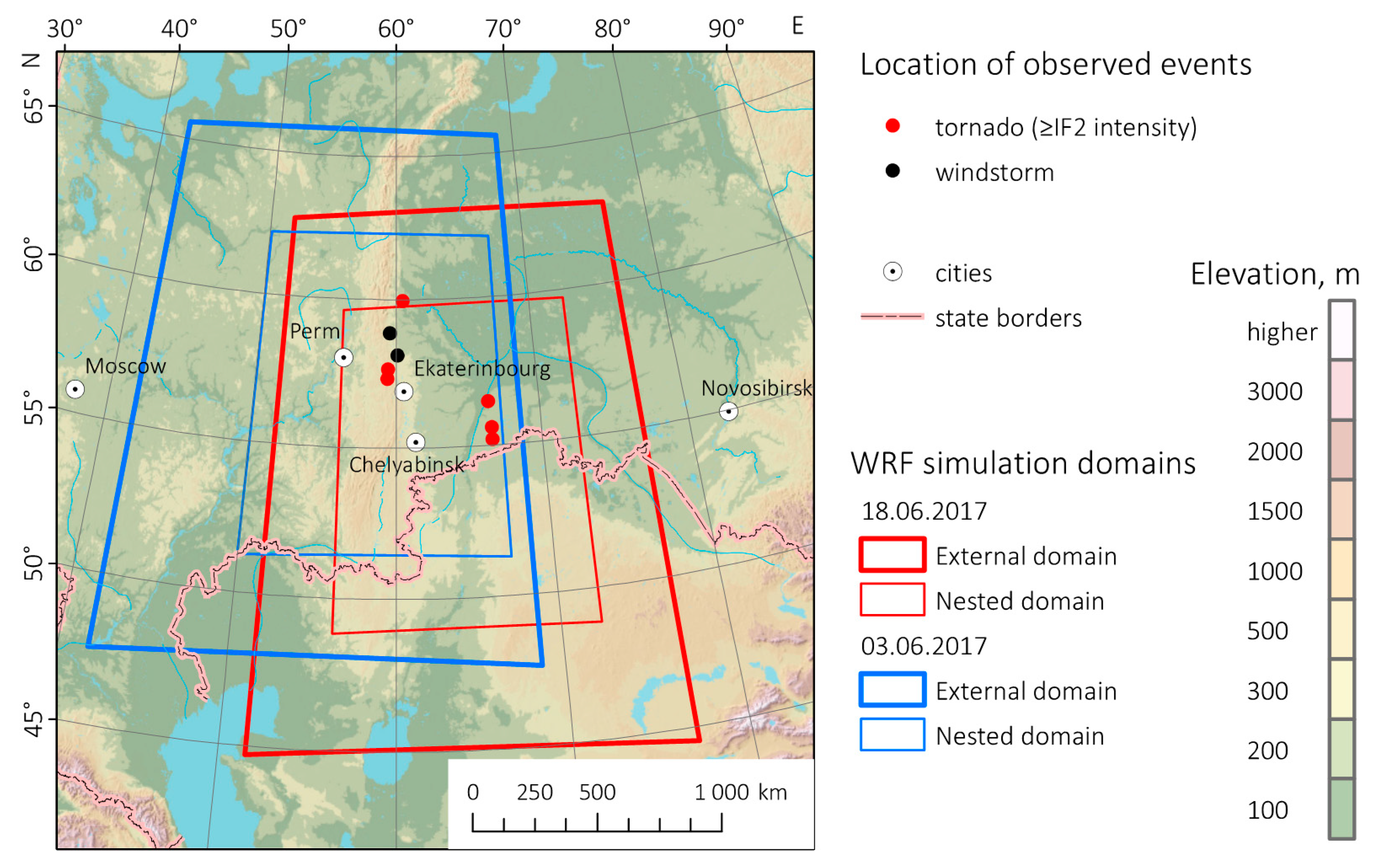
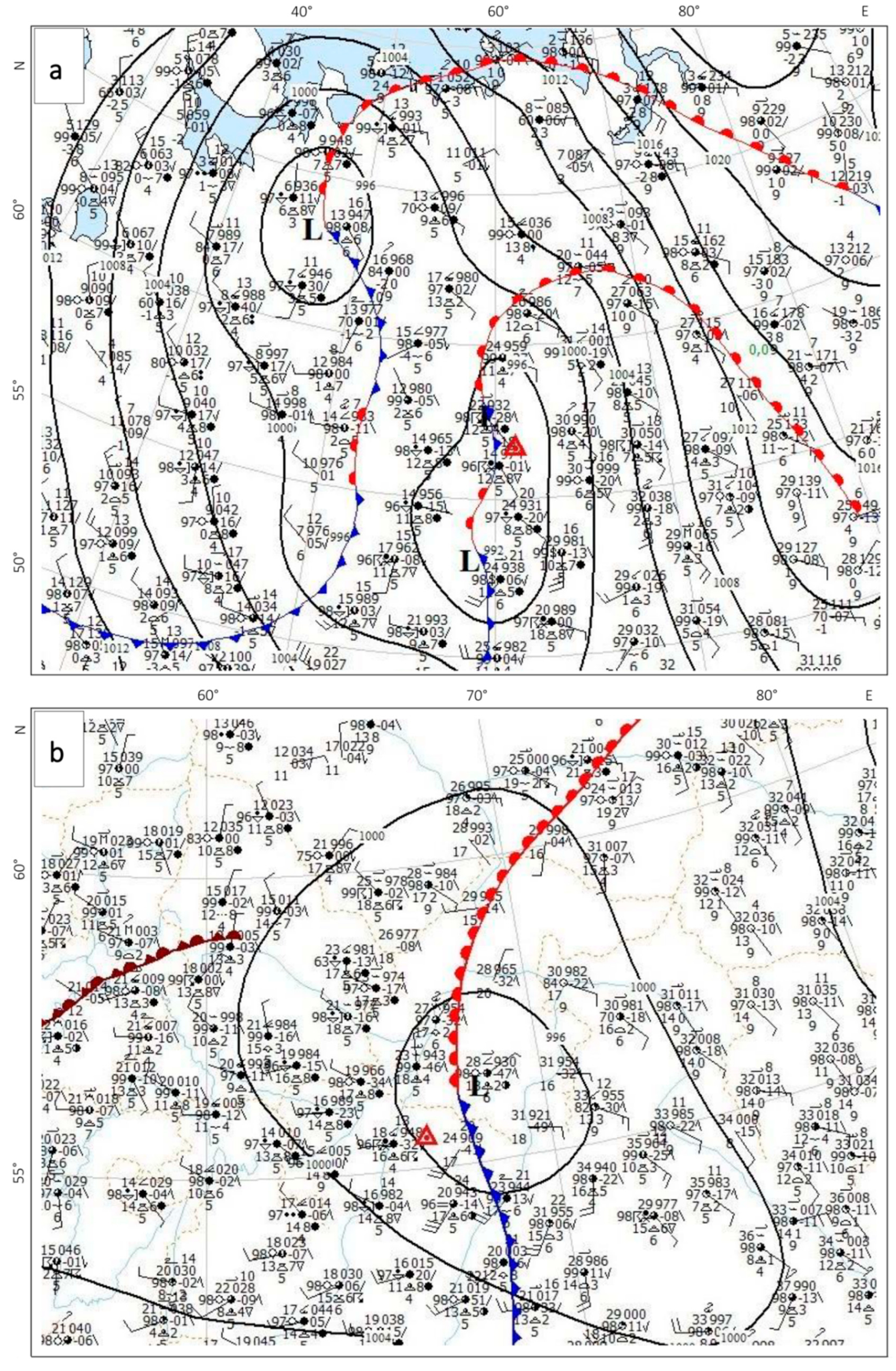
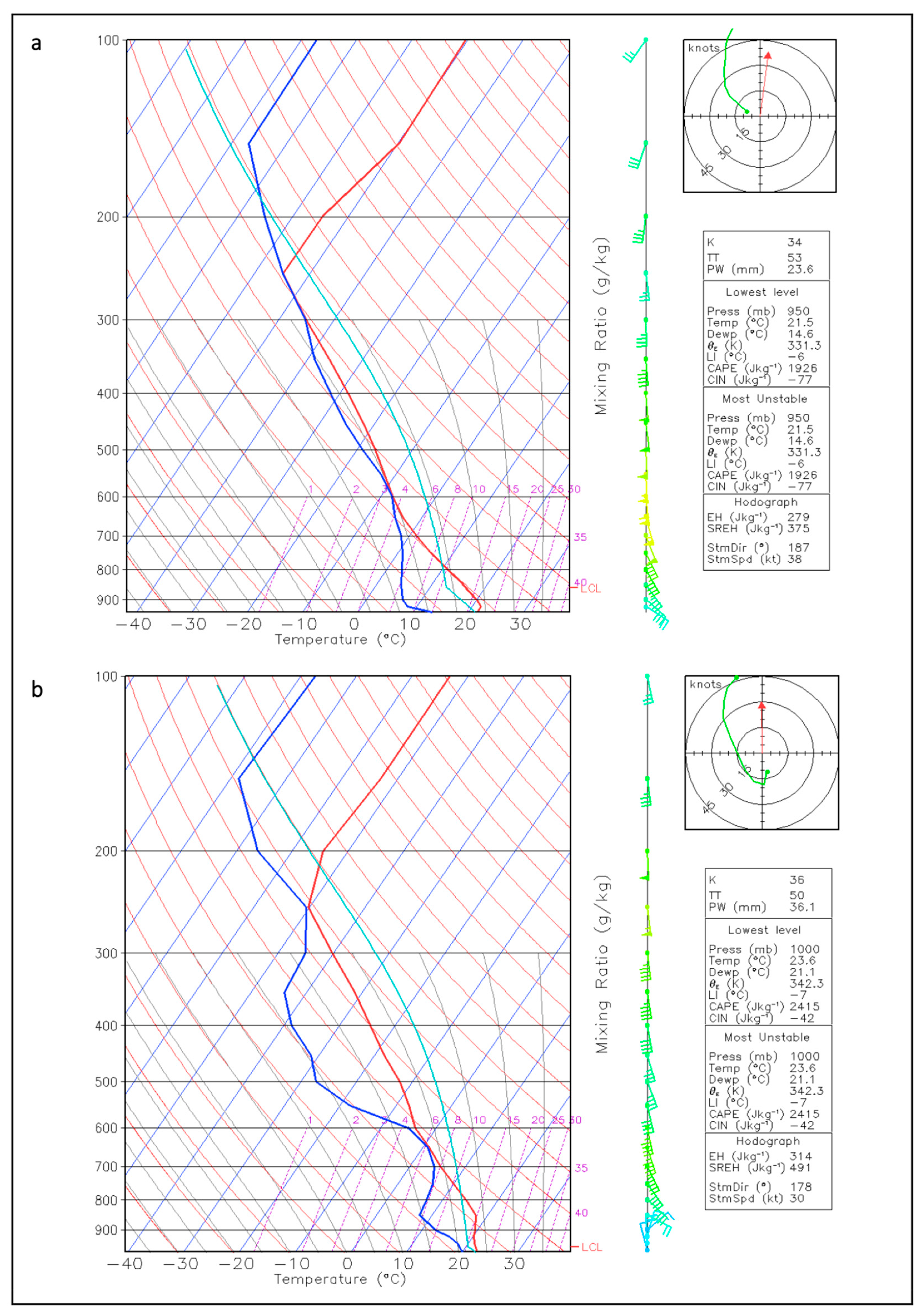

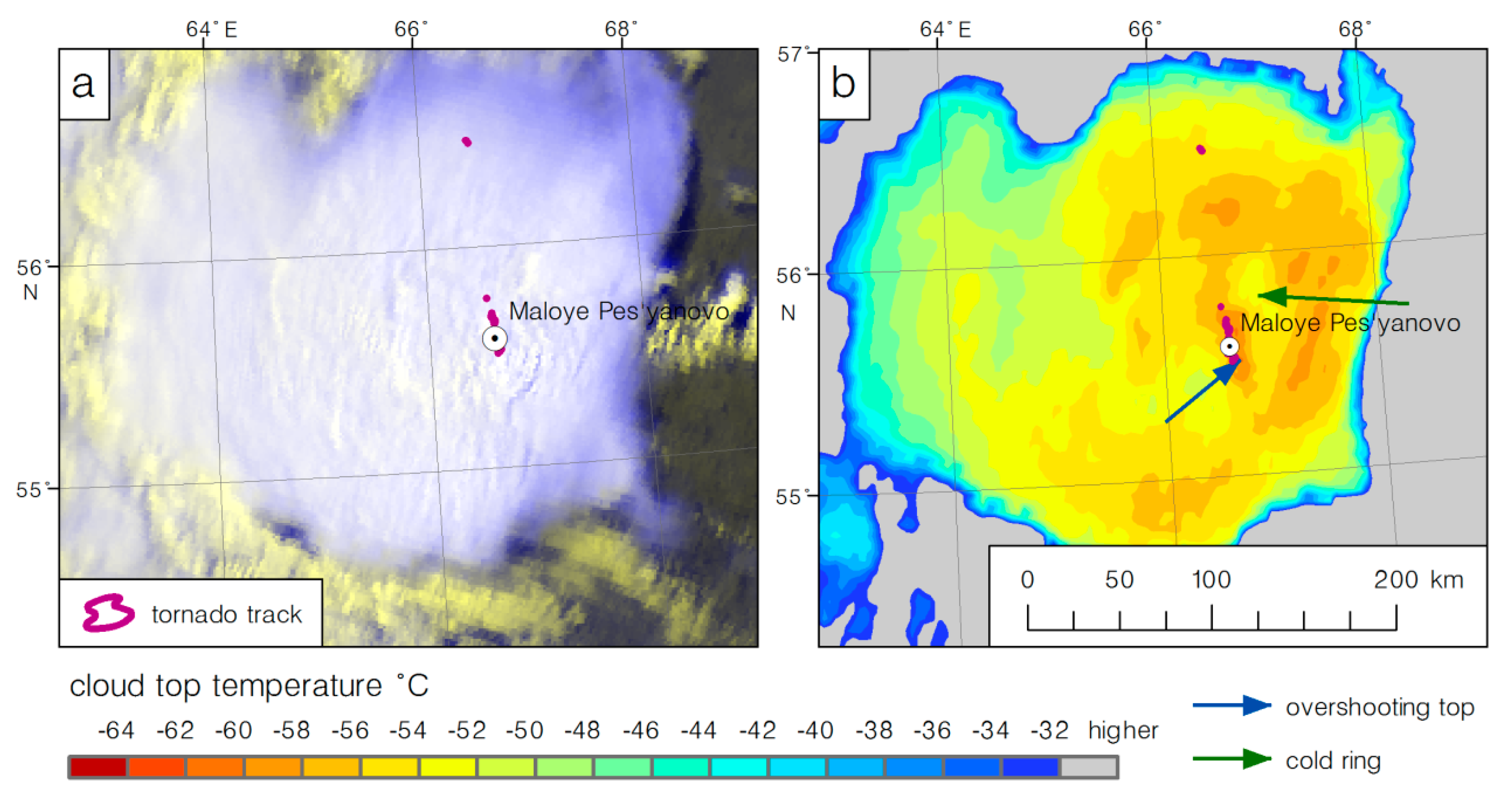
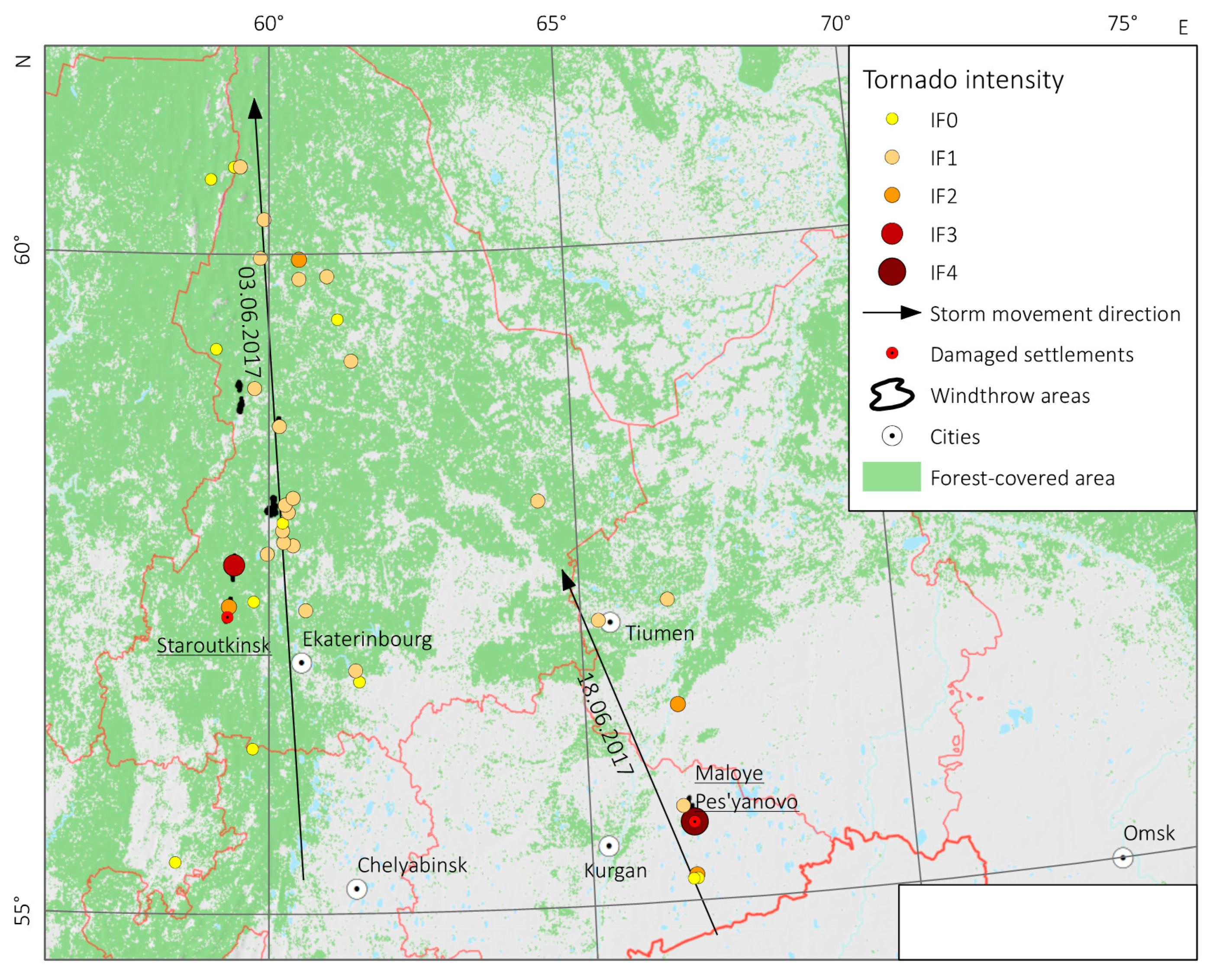
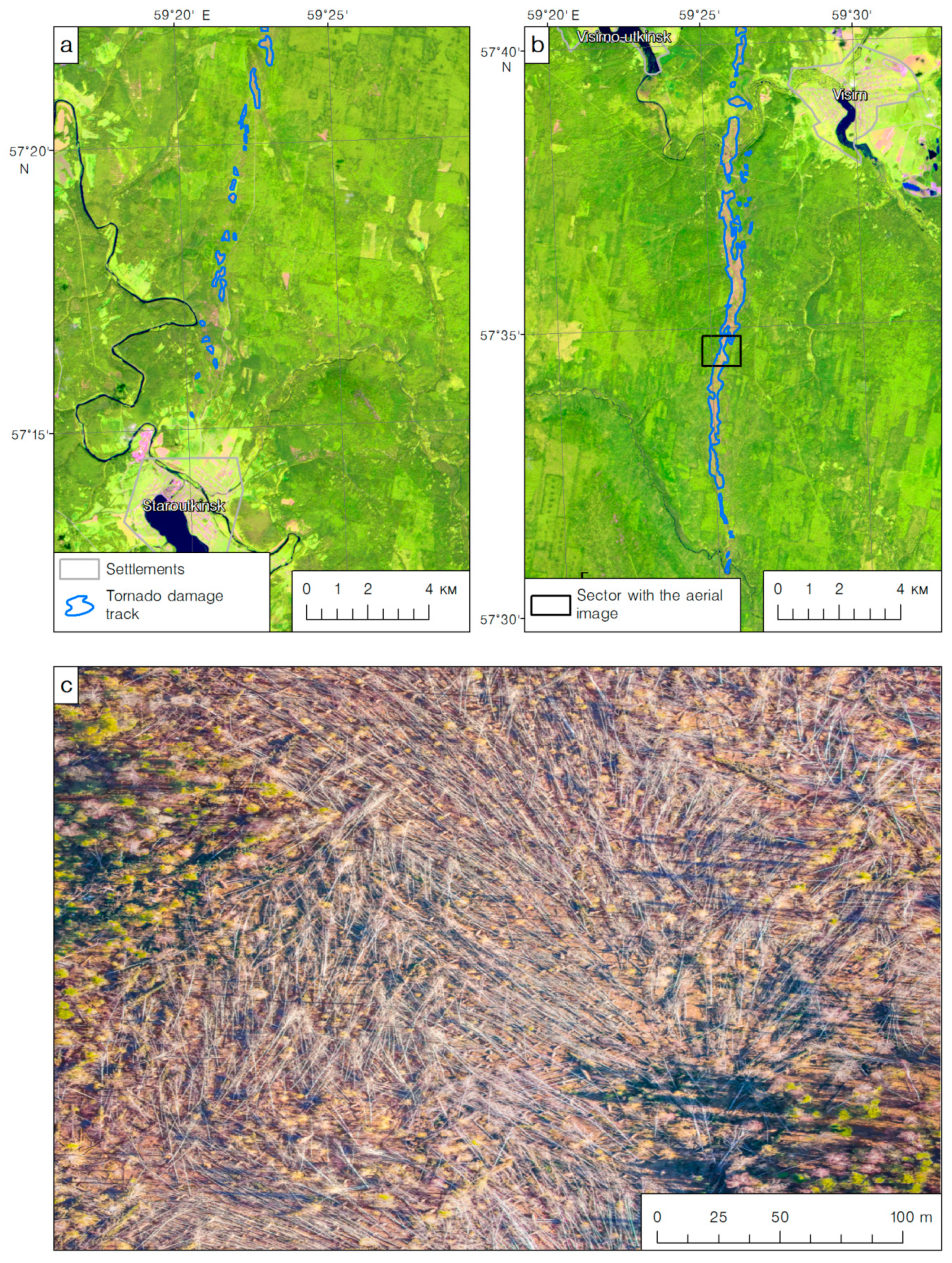
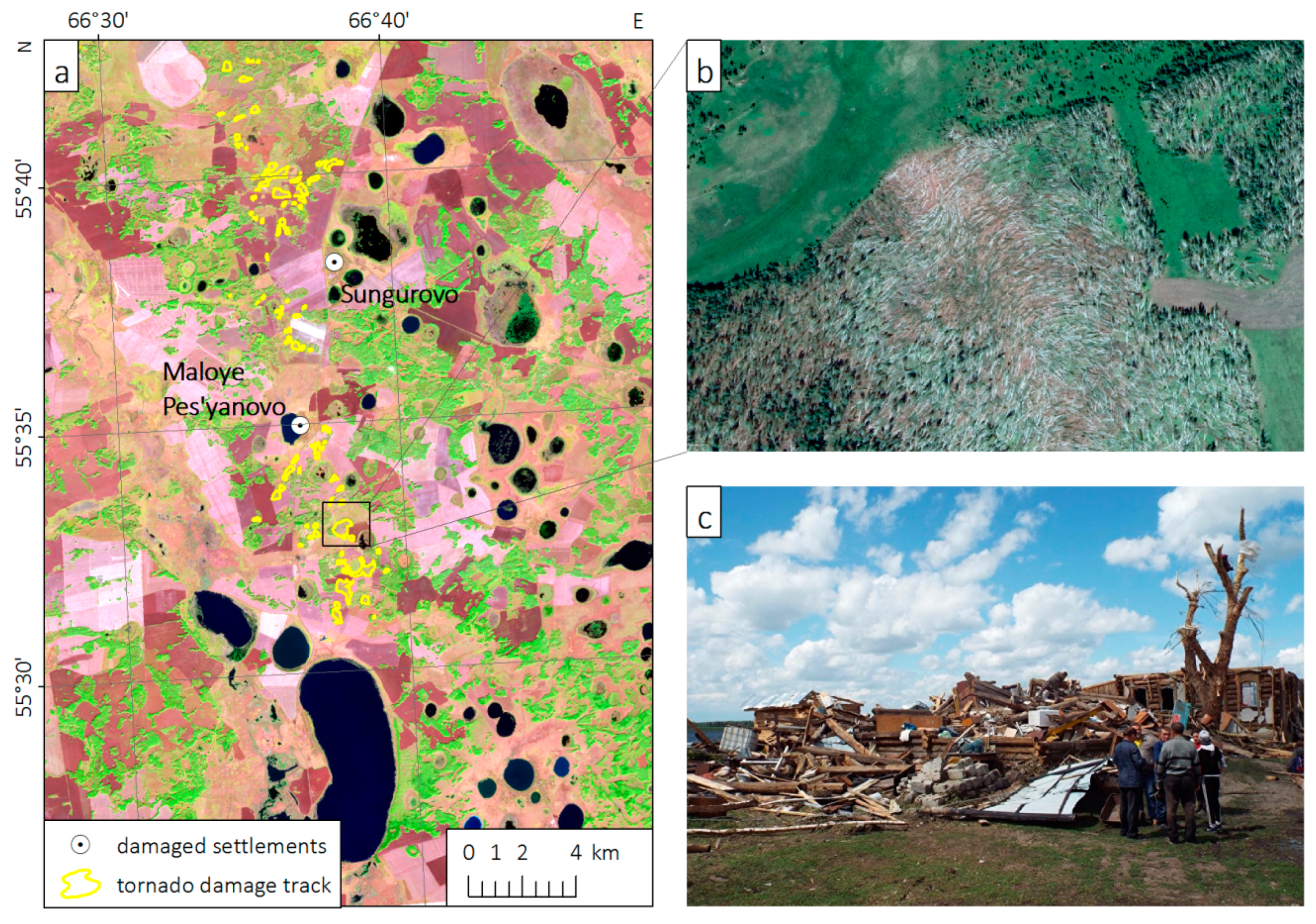

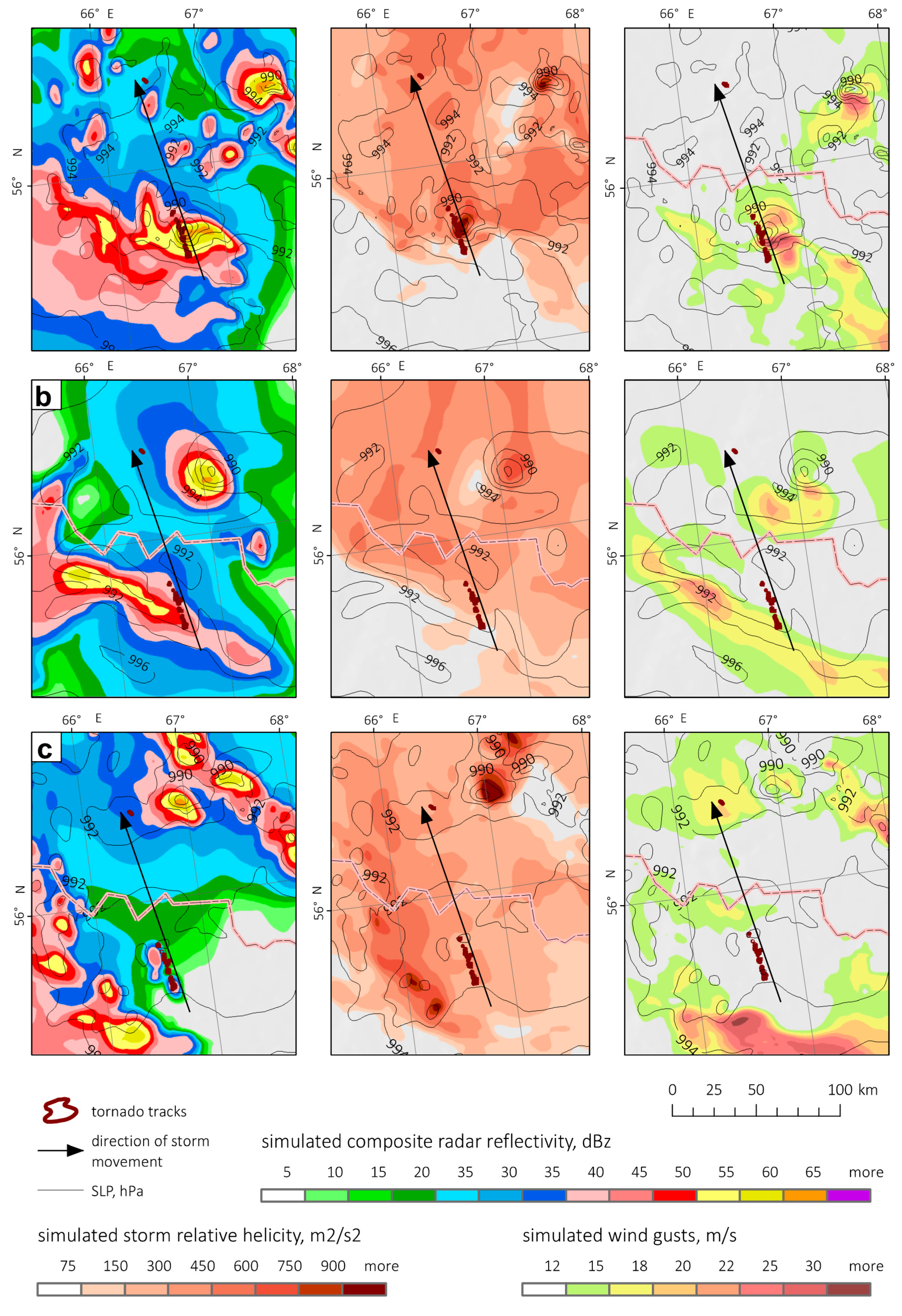
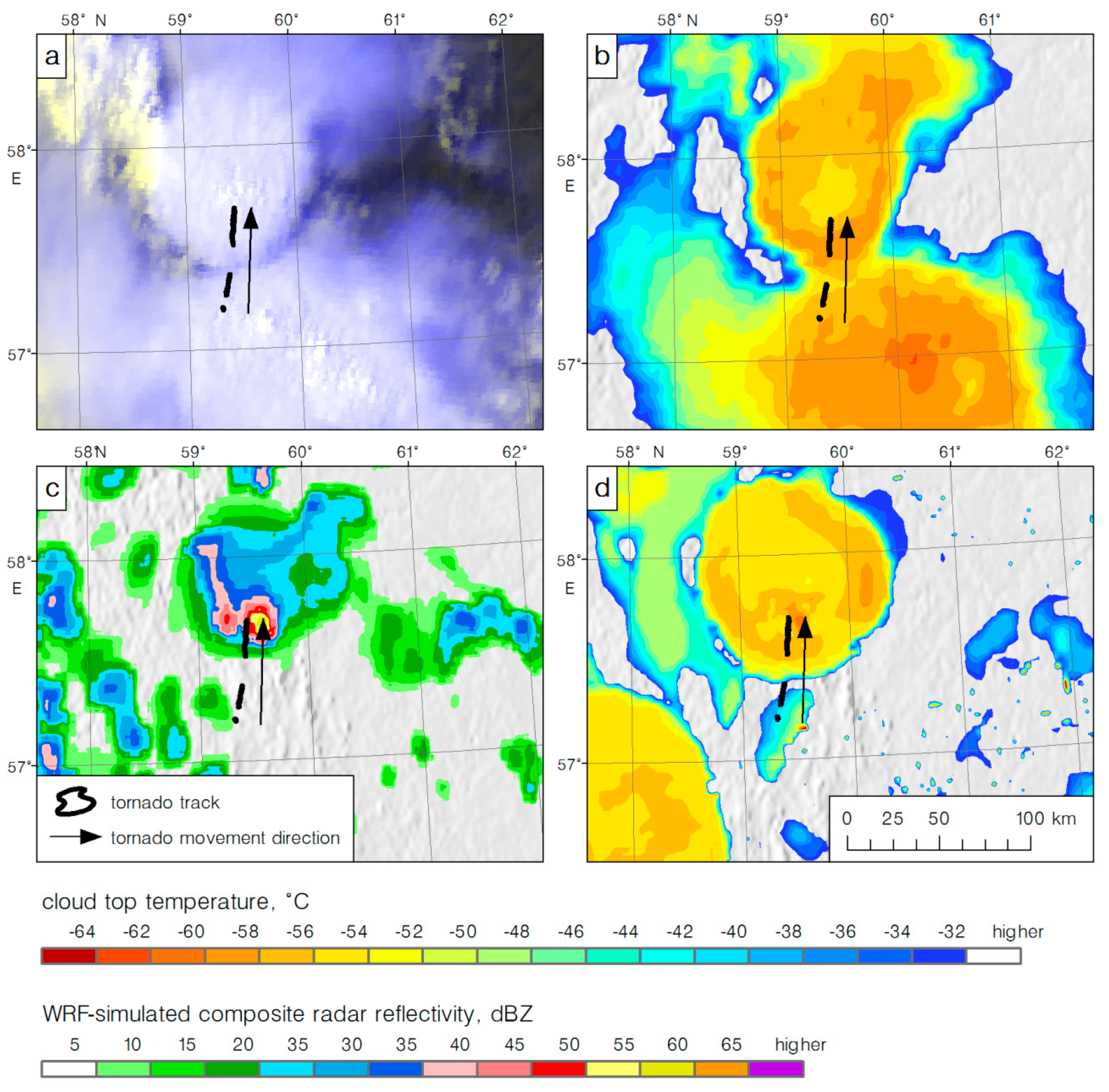
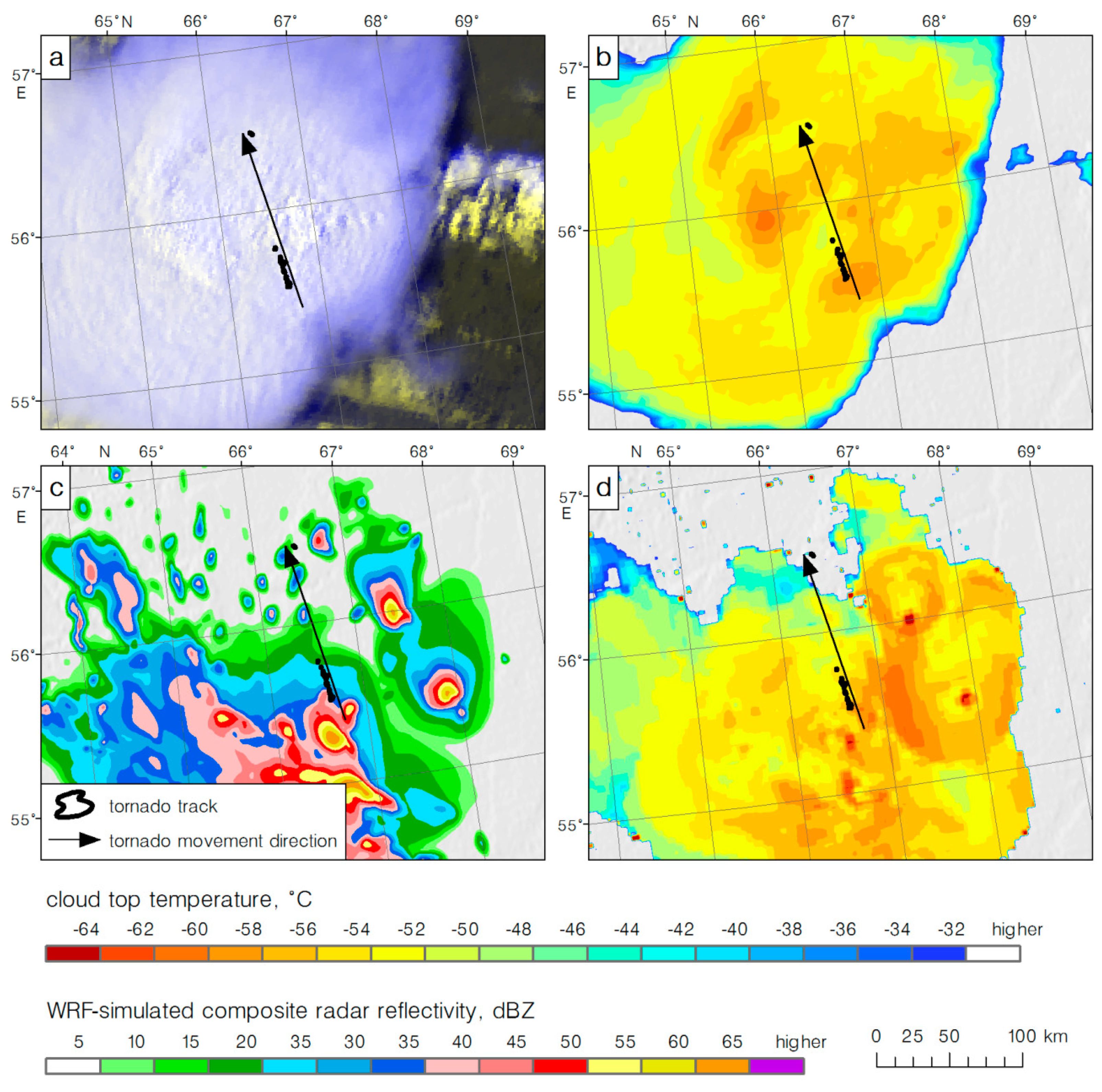

| Model Characteristic | Setting |
|---|---|
| Horizontal grid resolution and grid points | 7.2 km/278 × 278 (with no nested grid) |
| 3 km/600 × 600 (with no nested grid) | |
| 9 km/333 × 333, with one nested grid (3 km/400 × 400) | |
| Number of vertical layers (up to 50 hPa) | 38 |
| Topography | U.S. Geological Survey (USGS) DEM (30 s) |
| Simulation length | 27 h, 39 h, 51 h (for the 12-, 24-, and 36-h lead time, respectively) |
| Output data time step | 1 h |
| Dynamics | Non-hydrostatic |
| Model core | Advanced Research WRF (ARW), non-hydrostatic |
| Integration time step | 48 s (for 9 km grid), 36 s (for 7.2 km grid), or 18 s (for 3 km grid) |
| Initial and lateral boundary | 0.25° GFS analysis and forecast |
| Microphysics schemes | Thompson scheme [71] |
| Planetary Boundary Layer (PBL) scheme | Yonsei University scheme [72] |
| Land surface physics scheme | Noah Land Surface Model [73] |
| Long- and short-wave radiation scheme | Rapid Radiative Transfer Model (RRTM) [74] |
| Surface layer scheme | Monin-Obukhov with Carslon-Boland viscous sub-layer and standard similarity functions [75] |
| Convection | Explicit (cloud-resolving) modeling |
| Date, Time | SB CAPE, J Kg−1 | SB CIN, J Kg−1 | SB LI, °C | LLS, m s−1 | DLS, m s−1 | WMAX SHEAR, m2 s−2 | 0–3 km SRH, m2 s−2 | EHI | SCP | STP |
|---|---|---|---|---|---|---|---|---|---|---|
| 3 June 2017, 1200 UTC | 2200 1800 | −127 — | −8 −4 | 7 15 | 4 8 | 450 100 | 480 360 | 4.2 2.5 | 0.8 0.4 | 2.5 — |
| 18 June 2017, 1200 UTC | 4200 3000 | −72 — | −12 −8 | 11 12 | 21 14 | 1203 480 | 450 560 | 3.4 5.0 | 3.5 3.4 | 2.9 — |
| Date, Time (UTC) | Model Grid Size (km) and Nested Grid (Y/N) Resolution | WRF-Simulated Storm Parameters (Maximum Values in 50-km Radius around a Tornado Track) | ||
|---|---|---|---|---|
| 0–3 km SRH, m2 s−2 | Composite Reflectivity, DBZ | Wind Gust Speed, m s−1 | ||
| 03.06.2017, 1100–1200 | 7.2, N | 1200 | 42 | 13 |
| 3, N | 1075 | 58 | 13 | |
| 9, Y (3) | 770 | 47 | - | |
| 18.06.2017, 1200–1300 | 7.2, N | 610 | 56 | 23 |
| 3, N | 1200 | 64 | 31 | |
| 9, Y (3) | 990 | 58 | 31 | |
| Date, Time (UTC) | Model Grid Resolution (km) and Nested Grid (Y/N) Resolution | Minimum CTT, °C (Meteosat-8 data/WRF Model Forecast) | Distance between Observed and Simulated Storm Track, km | Timing Error, h |
|---|---|---|---|---|
| 03.06.2017, 1100–1200 | 7.2, N | −62/−61 | 40 | +1.25 |
| 3, N | −62/−61 | 10 | 0 | |
| 9, Y (3) | −62/−62 | 0 | −0.5 | |
| 18.06.2017, 1100–1200 | 7.2, N | −64/−62 | 35 | +1.5 |
| 3, N | −64/−64 | 10 | +1.5 | |
| 9, Y (3) | −64/−62 | 15 | +2.5 |
| Date, Time (UTC) | Model Start Date and Time (UTC) | WRF-Simulated Storm Parameters (Maximum Values in 50-km Radius around a Tornado Track) | ||
|---|---|---|---|---|
| 0–3 km Storm Relative Helicity (SRH), m2 s−2 | Composite Reflectivity, DBZ | Wind Gust Speed, m s−1 | ||
| 03.06.2017, 1100–1200 | 02.06.2017, 0000 | 1000 | 57 | 17 |
| 02.06.2017, 1200 | 1350 | 60 | 28 | |
| 03.06.2017, 0000 | 1075 | 58 | 13 | |
| 18.06.2017, 1200–1300 | 17.06.2017, 0000 | 600 | 52 | 30 |
| 17.06.2017, 1200 | 400 | 57 | 23 | |
| 18.06.2017, 0000 | 1200 | 64 | 31 | |
| Date, Time (UTC) | Model Start Date and Time (UTC) | Minimum Cloud Top Temperature, °C (Meteosat-8/WRF) | Distance between Observed and Simulated Storm Track, km | Timing Error, h |
|---|---|---|---|---|
| 03.06.2017, 1100–1200 | 02.06.2017, 0000 | −62/– | 50 | +1.25 |
| 02.06.2017, 1200 | −62/−64 | 15 | +1.5 | |
| 03.06.2017, 0000 | −62/−61 | 10 | 0 | |
| 18.06.2017, 1100–1200 | 17.06.2017, 0000 | −64/−61 | 50 | +1.25 |
| 17.06.2017, 1200 | −64/−62 | 35 | +1.0 | |
| 18.06.2017, 0000 | −64/−64 | 10 | +1.5 |
Publisher’s Note: MDPI stays neutral with regard to jurisdictional claims in published maps and institutional affiliations. |
© 2020 by the authors. Licensee MDPI, Basel, Switzerland. This article is an open access article distributed under the terms and conditions of the Creative Commons Attribution (CC BY) license (http://creativecommons.org/licenses/by/4.0/).
Share and Cite
Chernokulsky, A.; Shikhov, A.; Bykov, A.; Azhigov, I. Satellite-Based Study and Numerical Forecasting of Two Tornado Outbreaks in the Ural Region in June 2017. Atmosphere 2020, 11, 1146. https://doi.org/10.3390/atmos11111146
Chernokulsky A, Shikhov A, Bykov A, Azhigov I. Satellite-Based Study and Numerical Forecasting of Two Tornado Outbreaks in the Ural Region in June 2017. Atmosphere. 2020; 11(11):1146. https://doi.org/10.3390/atmos11111146
Chicago/Turabian StyleChernokulsky, Alexander, Andrey Shikhov, Alexey Bykov, and Igor Azhigov. 2020. "Satellite-Based Study and Numerical Forecasting of Two Tornado Outbreaks in the Ural Region in June 2017" Atmosphere 11, no. 11: 1146. https://doi.org/10.3390/atmos11111146





